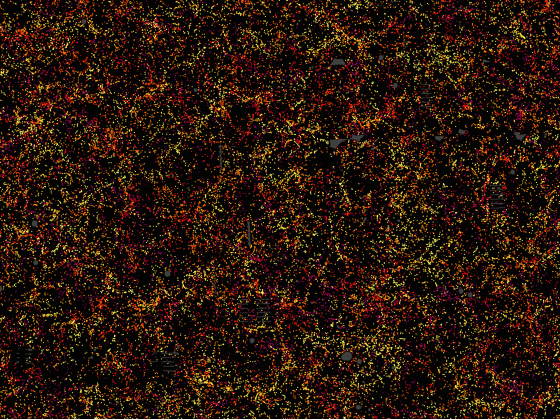Space Swoon: New Map of the Universe charts 1.2 Million Galaxies
Each point in this map isn’t a star, it’s a god damn galaxy. The map charts out a mere 650 cubic billion light years, which constitutes a quarter of the known Universe.
In an attempt to better understand the nature of the expansion of our universe, scientists have created a 3D map plotting the locations of 1.2 million galaxies. This map may help give astronomers new details about how the universe has been expanding, which will help us learn more about the mysterious force that scientists believe has been driving the expansion.
Published in a new study, the 3D map shows 650 cubic billion light years, which is just a quarter of the known universe. Each point in this map isn’t a star: it’s an entire galaxy. The map was created by scientists working on the Baryon Oscillation Spectroscopic Survey(BOSS), a program of the Sloan Digital Sky Survey III (SDSS-III).
BARYONIC ACOUSTIC OSCILLATIONS HELP US MEASURE THE UNIVERSEThis survey examined fluctuations in the density of regular matter, which serve as a “robust standard ruler for measurements of cosmic distances.” Those fluctuations, called baryonic acoustic oscillations, are an ideal tool for plotting the relative positions of each galaxy. In the map, the purple dots mark the galaxies that are farthest away, while the yellow ones represent galaxies that are closer to us. This is important, because it allows scientists to figure out the relative motion of each object, which in turn lets them determine just how fast they’re moving away from one another.
Scientists have always wondered exactly how big the universe is, but it wasn’t until 1929 that Edwin Hubble (the guy they named the telescope after) began measuring how galaxies move away from an observer. This is called a redshift, which occurs as the wavelength of energy lengthens, moving toward the red end of the spectrum. Hubble recognized that this meant that the universe itself was expanding. This is a fundamental theory that led to even bigger revelations, such as the Big Bang.
Scientists widely believed that the universe’s expansion would slow down, based on their calculations of the mass of the universe. However, in 1998, two teams of scientists discovered that the universe was not only continuing to expand, but the rate at which it was accelerating was actually increasing. A hypothetical, unseen force called dark energy is the commonly accepted theory for what is influencing its expansion.
Since then, astronomers have been working to understand the phenomenon. To this end, the team working on BOSS worked to measure the size of the baryon acoustic oscillations were across galaxies. Because those oscillations serve as excellent means with which to measure cosmic expansion, the survey was able to measure how dark matter and dark energy have influenced the rate at which the universe is expanding. The result is stunning: Rita Tojeiro, an astronomer with the University of St. Andrews, said in a statement that the team saw “a dramatic connection between the sound wave imprints seen in the cosmic microwave background 400,000 years after the Big Bang to the clustering of galaxies seven to twelve billion years later. The ability to observe a single well-modeled physical effect from recombination until today is a great boon for cosmology.”




